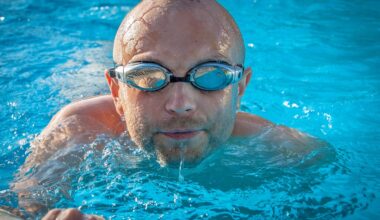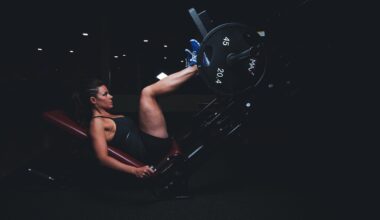Effective Recovery Techniques After Cycling Sessions
After an intense cycling session, the importance of recovery cannot be overstated. Recovery techniques are essential for preventing injury and improving performance. Engaging in proper post-ride practices allows the body to heal and enhances overall cycling experience. One effective technique is consuming a balanced snack rich in both carbs and protein within thirty minutes of completing your ride. This helps replenish glycogen stores and aids muscle recovery. Additionally, hydration plays a critical role; water or electrolyte drinks should be consumed to rehydrate lost fluids. Stretching can also be beneficial; consider incorporating static stretches targeting major muscle groups used during cycling. Another aspect to incorporate is foam rolling, which increases blood flow and reduces muscle tightness. Rest days are equally crucial; they allow your body to fully recover and adapt to training stresses. Listen to your body’s signals and prioritize adequate sleep, as this is essential for muscle repair and overall well-being. By implementing these effective recovery techniques, cyclists can enhance their performance and enjoyment during rides, setting the stage for future improvements. Consistent application of these strategies can yield significant benefits over time, especially for avid cycling enthusiasts.
Importance of Hydration in Recovery
Hydration is vital for recovery post-cycling and significantly influences performance. While cycling, your body loses fluids through sweat and breathing; thus, replacing these fluids timely is essential. Dehydration can lead to fatigue, muscle cramping, and reduced performance levels, which can hinder recovery efforts. Aim to drink sufficient fluids before, during, and after your cycling sessions. Water is often adequate for shorter rides; however, for long rides exceeding 90 minutes, consider electrolyte drinks to replenish lost minerals. Remember to monitor your urine color as an indicator of hydration status; pale yellow indicates proper hydration levels. Incorporating hydrating foods such as watermelon, oranges, or cucumbers can also aid fluid balance. Post-ride, make it a point to consume at least 500-750 mL of fluids within the first hour to optimize recovery. Cold drinks might seem refreshing but can also aid faster absorption. Understanding your body’s hydration needs and adapting your intake accordingly ensures a more effective recovery process. By emphasizing hydration, cyclists can combat fatigue, enhance endurance, and promote healing, leading to a more successful riding experience in the long run.
Another crucial recovery technique is the practice of effective stretching. Post-ride stretching helps maintain flexibility and prevent injury from tight muscles. Focus on major muscle groups that were heavily engaged during cycling, such as quadriceps, hamstrings, calves, and hip flexors. Hold each stretch for at least 30 seconds to ensure your muscles receive adequate relief. Consider dynamic stretches before cycling; however, post-ride routines should focus on static stretching for optimal recovery. Adding yoga or pilates into your routine also enhances flexibility and core strength, benefiting overall cycling performance. For those who experience muscle soreness, gentle post-ride yoga can significantly alleviate discomfort while providing a relaxing cooldown. Integrating stretching gradually into your routine ensures improved performance over time. While stretching at home is effective, participating in group classes can provide motivation and variety. Enlist the help of a certified trainer if uncertain about proper techniques, as improper stretching can lead to injuries. Ultimately, incorporating stretching processes efficiently into your recovery routine not only benefits flexibility but helps maintain the body’s functionality, contributing to longer cycling sessions and enjoyment.
Foam Rolling for Muscle Recovery
Foam rolling is an excellent complementary recovery technique for cyclists to alleviate muscle soreness and tension. This self-myofascial release technique promotes faster healing and enhances blood circulation to working muscles. Begin by targeting the major muscle groups used during cycling, such as glutes, hamstrings, quads, and calves. Use slow movements over each muscle group; spend at least 30 seconds on each area to release tightness effectively. Pay attention to tender spots, as these knots may indicate areas needing more focus. Always maintain proper body positioning for improved pressure application while foam rolling. Incorporate rolling into your post-ride routine; doing so can decrease muscle soreness substantially, increasing comfort level after cycling. Benefits include increased range of motion, improved recovery time, and reduced overall muscle stress. Many athletes find foam rolling effective in minimizing injuries caused by overuse. Aim to perform foam rolling sessions multiple times a week for optimal results. Utilizing foam rolling correctly helps ensure that the body recovers well from cycling workouts, allowing for a smoother transition to future training sessions and competitions, ultimately enhancing performance.
Rest days hold significant importance in any training regimen, including cycling. Engaging in continuous cycling without adequate rest can lead to burnout, increased injury risk, and diminished performance. By implementing regular, planned rest days into your schedule, your body can recover from strain, recharge energy levels, and allow muscle fibers to heal. Aim to take at least one to two rest days per week, prominently listening to your body’s signals for fatigue or discomfort. Active recovery on rest days can also be beneficial; consider light activities such as walking, swimming, or easy cycling for longer sessions in a relaxed manner. These activities promote blood circulation without further stressing tired muscles. Combine your rest strategy with proper sleep, aiming for 7-9 hours nightly, as this is when the body undergoes significant repair processes. In addition, prioritize your nutrition during rest days to ensure you consume adequate nutrients for recovery. Rest days enable cyclists to rebound stronger during subsequent workouts, ensuring sustained improvement. Consistent application of planned rest days will ultimately contribute to a successful long-term cycling experience, revitalizing enthusiasm and dedication.
The Role of Nutrition in Recovery
Nutrition plays an integral role in facilitating optimal recovery post-cycling. A well-balanced diet supports overall health, aiding muscle repair and restoring energy levels. Within thirty minutes after a ride, it’s essential to consume a recovery meal or snack containing carbohydrates and protein. This meal helps replenish glycogen stores while promoting muscle healing. Choose easily digestible foods such as yogurt with fruits, protein shakes, or whole-grain sandwiches to restore energy effectively. Furthermore, ensure meals incorporate healthy fats such as avocados or nuts, which provide vital nutrients while assisting in inflammation reduction. Prioritize meals rich in antioxidants, like berries and dark leafy greens, to combat oxidative stress caused by intense exercises. Hydration should not be overlooked; fluids consumed contain electrolytes needed for recovery. Consider eating varied foods rich in vitamins and minerals to support the immune system, which can be compromised by extensive training. Paying attention to your nutritional intake aids recovery, leading to higher performance gains and greater consistency in training. Ultimately, ensuring proper nutrition supports muscle recovery, allows cyclists to enjoy rides more, and optimizes endurance for future sessions.
Lastly, maintaining a positive mental attitude is essential during recovery after cycling. The psychological aspect of cycling performance can greatly impact recovery strategies. Recognize any fears or anxieties that may arise during rides or training, as these feelings can hinder progress. Establishing achievable goals helps maintain motivation and fosters a sense of accomplishment. Consider engaging in mindfulness practices or meditation. These techniques can improve focus and reduce stress levels, leading to an overall sense of well-being. Connecting with fellow cyclists or communities offers support and encouragement, enhancing the recovery experience. A positive mindset can significantly contribute to preventing burnout and frustrations that often accompany rigorous training environments. Keeping training logs to track performance particularly aids in assessing progress and celebrating achievements. Additionally, engaging in diverse cycling experiences may enhance enjoyment levels and reduce recovery burdens. The journey of cycling involves both physical and mental growth; recognizing this balance enriches the overall cycling experience. Ultimately, cultivating a healthy mental attitude can significantly benefit recovery and promote sustained improvement and passion for cycling.
This concludes our discussion on effective recovery techniques post-cycling sessions. Ensuring a comprehensive approach enhances the effectiveness of the ways mentioned. By integrating hydration, nutrition, stretching, foam rolling, rest, and a positive mindset, cyclists can optimize their recovery processes. Each technique plays a significant role in facilitating muscle repair, preventing injuries, and setting the foundation for improved performance. Establishing a coherent routine will ensure that these strategies smoothly integrate into a cyclist’s lifestyle. It’s crucial to remain patient and consistent throughout this process, as meaningful results take time to manifest. Consistently implementing these strategies fosters greater enjoyment and an overall rewarding cycling experience. Moreover, remember the influence of community; connecting with others can provide ample encouragement and motivation for adopting these techniques. Try to document your progress as you integrate these recovery processes into your training approach. Through careful attention to recovery, cyclists gain the potential to cycle longer distances while feeling revitalized. Fine-tuning recovery strategies allows for continual performance improvement, supporting not only effective riding but also a lifelong commitment to cycling enjoyment.


